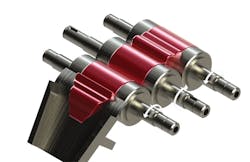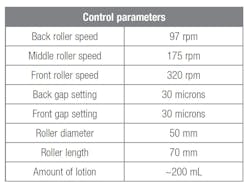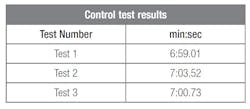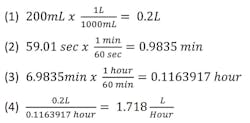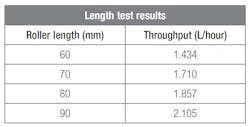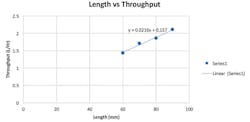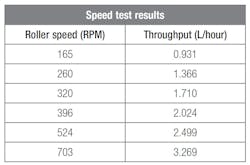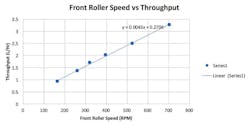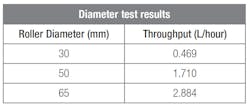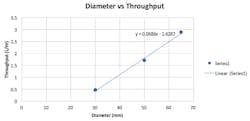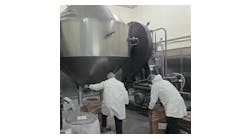Did you ever see a three-roll mill in action and wonder how much can it mill? Did you notice a good dispersion of the final product and begin to wonder if this machine could be the next one you need, but are unsure? That big question can be answered with help from some experiments based on different roller sizes and different speeds to show how machine performance could affect throughput.
A three-roll mill is used mostly for dispersion, but does some grinding as well. It uses three rollers of different speeds and directions to cause the sheer force between them to disperse and grind particles. The three-roll mill is used to disperse material within a media, which is usually some type of semi-viscous material such as cream. The media is fed into the back roller and the final product will dispense onto the apron as shown in Figure 1.
Materials
Torrey Hills Technologies conducted an experiment using three different mills all with ceramic rollers, but of different sizes. Rollers were 30 millimeter (mm), 50 mm and 65 mm in diameter with lengths that could be controlled by guides. Lotion (Lucerne) was used as the milling media as it has a viscosity similar to products commonly milled in process industries.
Procedure
This experiment was conducted with three varying parameters – length, speed and diameter – while keeping all other factors unchanged. Length, speed and diameter were changed to see how each would have a different effect on the throughput from the control. The control used was a 50-mm diameter three-roll mill. The parameters are shown in Table 1.
The typical parameters used to mill products were chosen for the experiment. Three tests were run for each parameter to account for any human error in measuring the amount of lotion. Also, after each run, all the parameters were checked to ensure they had not shifted, and if so, they were recalibrated to proper position. This step was a precaution to ensure all data was as accurate as possible. The data gathered is shown in Table 2.
From this data, throughput could be calculated by putting the amount over the time. From there, the units were converted into liters per hour (L/hour) to estimate how much media it could pass through.
This is how all the throughputs were calculated throughout the experiment. The average of the three experiments totals 1.710 L/hour for the throughput of the control.
Length experiment
In this experiment, the guides of the machine were adjusted to give varying lengths. Being able to vary the guides is a key part of the three-roll mill as it allows adjustment of the area for milling. To minimize waste, the guides can be pushed out lowering the effective length of the rollers. A variety of lengths were tested to see the correlation between smaller and longer lengths than the control. The varying lengths used were 60 mm, 80 mm and 90 mm. As before, all other parameters were fixed and measured in between each test. The end result of the experiments with all of the averages are shown in Table 3.
From this data, a trend was plotted by adding the control data to create Figure 2.
Figure 2 shows a linear trend with every 1 mm of increase resulting in 0.022 liters of output per hour. This data shows that the surface area has a linear increase, which directly has a linear increase on the throughput of the machine.
Speed experiment
This experiment varied the speeds of each roller to provide the force for milling. Running at faster speeds is typical, but for more viscous substances, running at a slower speed can help avoid slipping. Seeing how much slower or faster a machine can run will can impact throughput. For this experiment front roller speeds of 165, 260, 396, 524 and 703 rpm were set. The results of the experiment are shown in Table 4.
This data was then graphed to produce the trend in Figure 3.
It is interesting to see that this also has a linear trend. A more exponential trend was expected as the speed of the rollers can have unique interactions based on the material. The material was expected to either sometimes slip on the top of the roller as speed increased or have problems transferring to the other roller. With the settings provided and material used, the roller speed had a linear trend of a 1 rpm increase and caused a 0.004 L/hour increase.
Diameter experiment
In this experiement the diameters of the rollers were varied by using different machines. Some problems occurred with finding machines that had the same gear ratios and even though all the rollers were ceramic, the processes in making those rollers were different. These factors, which could skew results, were compensated for. In the end, the different machines were run and previous data from the speed experiment was used to calibrate the output with the same slope. The diameter of all three machines was 30, 50 and 65 mm. The data produced is shown in Table 5.
From this data, the results were plotted on a graph to provide a conclusion.
Figure 4 also shows a linear trend. The slope of this trend is much steeper as the surface area in regard to the diameter goes as a function of a square of the radius. This means that for each 1 mm of diameter increase there is 0.069 L/hour of throughput gain.
Conclusion
The data shows that an increase in any of the parameters – length, speed and diameter – will lead to an increase in throughput. What do these trends mean together and how do they help end users determine what is needed? First, determine a budget. Then use the diameter of the rollers as a base for selecting a machine. A larger diameter gives better throughput and has the ability to grind thicker materials, but it also takes up more space and has a larger price point. Consider the toughness of material to be rolled and if a larger diameter is required.
After the ideal diameter has been determined, find out what length is necessary. Rollers can come from a variety of lengths offering multiple options depending on throughput or material saving needs. All machines should come with guides that allow users to further adjust gap needs to smaller settings, so first determine the maximum output capacity and then go back from there.
The last setting to consider is the speed and gear ratio of the rollers. Either a 1-to-2 or 1-to-3 gear ratio is recommended for best results. Again, this depends on your application and material. The lower gear ratios will have a lower top speed, which can work well for highly viscous materials.
Overall, finding the most suitable machine is a balance. The biggest rollers do not necessarily give the best throughput, especially when budget is factored in. If the goal is to run creams or lotions at a decent-size volume, a three-roll mill of 50 mm diameter would be sufficient. For media, such as pastes, which may require a stronger machine, a 65 mm diameter three-roll mill would be suitable. Many parameters can be adjusted to produce the desired input, but with these best practices, you will know how much is too much and what size is right for you.
Justin Cheung is a research and development (R&D) engineer at Torrey Hills Technologies where he has worked since 2015 on a variety of mixing equipment products as well as R&D projects. Cheung graduated in 2010 from California Polytechnic University, San Luis Obispo in electrical engineering. In 2014 he received his master’s in electrical and computer engineering with a specialty in materials from the University of California, San Diego.
